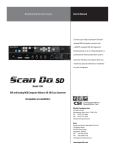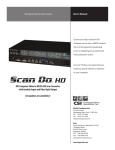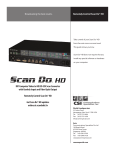Download 7600 Series
Transcript
Communications Specialties’ Fiberlink® 7600 User’s Manual Distribute HDMI and stereo audio over one single mode or multimode fiber with no compression, scaling, conversions or frame dropping. The 7600 Series is feature rich, including our unique EDID function and Pixel Clock phase selections. Fiberlink® 7600 Series HDMI with Stereo Audio Transmission over one single mode or multimode fiber. World Headquarters 125 Comac Street Ronkonkoma, New York 11779 USA Tel: (631) 273-0404 Fax: (631) 273-1638 [email protected] commspecial.com Fiberlink® 7600 Series Contents Contents Welcome . . . . . . . . . . . . . . . . . . . . . . . . . . . . . . . . . . . . . . . . . . . . . . . . . . . . . . . . . . . . . . . . . . . . . . . . . . . . 3 Features. . . . . . . . . . . . . . . . . . . . . . . . . . . . . . . . . . . . . . . . . . . . . . . . . . . . . . . . . . . . . . . . . . . . . . . . . . . . . 3 Package Contents. . . . . . . . . . . . . . . . . . . . . . . . . . . . . . . . . . . . . . . . . . . . . . . . . . . . . . . . . . . . . . . . . . . . 3 Technical Specifications. . . . . . . . . . . . . . . . . . . . . . . . . . . . . . . . . . . . . . . . . . . . . . . . . . . . . . . . . . . . . . 4 7600 Transmitter Specifications. . . . . . . . . . . . . . . . . . . . . . . . . . . . . . . . . . . . . . . . . . . . . . . . . . . . . . . 4 HDMI Specifications. . . . . . . . . . . . . . . . . . . . . . . . . . . . . . . . . . . . . . . . . . . . . . . . . . . . . . . . . . . . . . . . . . 4 Audio Specifications . . . . . . . . . . . . . . . . . . . . . . . . . . . . . . . . . . . . . . . . . . . . . . . . . . . . . . . . . . . . . . . . . 4 7600 Transmitter Optical Specifications. . . . . . . . . . . . . . . . . . . . . . . . . . . . . . . . . . . . . . . . . . . . . . . 5 7601 Receiver HDMI Output. . . . . . . . . . . . . . . . . . . . . . . . . . . . . . . . . . . . . . . . . . . . . . . . . . . . . . . . . . 5 7601 Receiver Specifications . . . . . . . . . . . . . . . . . . . . . . . . . . . . . . . . . . . . . . . . . . . . . . . . . . . . . . . . . 6 7600 General Specifications. . . . . . . . . . . . . . . . . . . . . . . . . . . . . . . . . . . . . . . . . . . . . . . . . . . . . . . . . . 6 Installation Instructions. . . . . . . . . . . . . . . . . . . . . . . . . . . . . . . . . . . . . . . . . . . . . . . . . . . . . . . . . . . . . . 7 EDID Functions . . . . . . . . . . . . . . . . . . . . . . . . . . . . . . . . . . . . . . . . . . . . . . . . . . . . . . . . . . . . . . . . . . . . . . 8 EDID Functions (cont). . . . . . . . . . . . . . . . . . . . . . . . . . . . . . . . . . . . . . . . . . . . . . . . . . . . . . . . . . . . . . . . 9 Operating Tips. . . . . . . . . . . . . . . . . . . . . . . . . . . . . . . . . . . . . . . . . . . . . . . . . . . . . . . . . . . . . . . . . . . . . . . 9 Video Adjust Switch. . . . . . . . . . . . . . . . . . . . . . . . . . . . . . . . . . . . . . . . . . . . . . . . . . . . . . . . . . . . . . . . . . 9 Using 9-Volt Battery. . . . . . . . . . . . . . . . . . . . . . . . . . . . . . . . . . . . . . . . . . . . . . . . . . . . . . . . . . . . . . . . . . 9 Alarm Switch Settings & Options . . . . . . . . . . . . . . . . . . . . . . . . . . . . . . . . . . . . . . . . . . . . . . . . . . . . 10 Indicator LEDs . . . . . . . . . . . . . . . . . . . . . . . . . . . . . . . . . . . . . . . . . . . . . . . . . . . . . . . . . . . . . . . . . . . . . . 11 Operating Pointers. . . . . . . . . . . . . . . . . . . . . . . . . . . . . . . . . . . . . . . . . . . . . . . . . . . . . . . . . . . . . . . . . . 12 Troubleshooting. . . . . . . . . . . . . . . . . . . . . . . . . . . . . . . . . . . . . . . . . . . . . . . . . . . . . . . . . . . . . . . . . . . . 12 Maintenance. . . . . . . . . . . . . . . . . . . . . . . . . . . . . . . . . . . . . . . . . . . . . . . . . . . . . . . . . . . . . . . . . . . . . . . . 13 Certifications . . . . . . . . . . . . . . . . . . . . . . . . . . . . . . . . . . . . . . . . . . . . . . . . . . . . . . . . . . . . . . . . . . . . . . . 13 Warranty and Repairs . . . . . . . . . . . . . . . . . . . . . . . . . . . . . . . . . . . . . . . . . . . . . . . . . . . . . . . . . . . . . . . 14 Page 2 Fiberlink® 7600 Series User’s Manual Fiberlink® 7600 Series Welcome | Features | Package Contents Welcome Thank you for purchasing Communications Specialties, Inc.’s Fiberlink® 7600 Series. The 7600 Series is used to transmit pristine HDMI with stereo audio over a single fiber optic core. Compatible with single mode or multimode fiber, the 7600 is ideal for the most demanding of applications, from distance learning to rental and staging. The 7600 offers a unique EDID function that allows you to generate EDID internally, or you can capture and permanently store EDID information. Features •Supports HDMI resolutions up to 1920 x 1200 at 165 MHz pixel clock and HDTV resolutions of 480p, 720p, 1080i, and 1080p •Unique 0/180 degree pixel clock selection to compensate for HDMI cable skew • Supports embedded stereo audio from the HDMI source •Uses no compression, frame dropping, or scaling for crystal clear signals •Only one fiber used - no pixel skewing •Supports EDID from internal generation, or capture and storage. •Transmits signals over one single mode or multimode fiber optic core. •RoHS Compliant Package Contents •One Fiberlink® 7600 or 7601. •This User’s Manual Fiberlink® 7600 Series User’s Manual Page 3 Technical Specifications Fiberlink® 7600 Series Technical Specifications 7600 Transmitter Specifications Number of Inputs: One HDMI up to 165MHz Pixel Clock Connector: One female HDMI type A with screw lock Spatial Resolutions: 480i, 480p, 720p, 1080i, 1080p, 1920x1200p; 50, 59.94 and 60 Hz vertical refresh Color Resolutions: 8-Bits per pixel; pixel-for-pixel sampling HDMI Embedded Audio: 2 channels EDID: Ability to capture EDID from target monitor or internal default resolutions Color Space Support: 8-Bit RGB or YCrCb HDMI Specifications HDCP: Compliant with High-bandwidth Digital Content Protection (HDCP) using HDMI standards HDMI Version Support: v1.0: Fully supported v1.1: Fully supported v1.2: Fully supported v1.2a: Fully supported (*) v1.3: Fully supported (*) v1.3a: Fully supported (*) v1.4: Supported (*)(**) v2.0: Supported (*)(**) (*) 24-bit video, max video clock of 165MHz and 2ch PCM audio are enforced via EDID protocol. CEC (Consumer Electronics Control) is not supported. (**) ARC (Audio Return Channel) or HEC (HDMI Ethernet Channel) are not supported. Audio Specifications Number of Audio Channels Page 4 2, unbalanced Fiberlink® 7600 Series User’s Manual Technical Specifications Fiberlink® 7600 Series Technical Specifications 7600 Transmitter Optical Specifications Emitter Type FP Laser Operating Wavelength 1310nm Optimal Optical Fibers SM: 8-10/125 microns; MM: 50u or 62.5u Optical Connector ST Class I Laser Product complies with FDA performance standard for laser products, Title 21, Code of Federal Regulations, Sub-Chapter J. 7601 Receiver HDMI Output Number of Outputs 1 Connector One Female HDMI type A with screw lock Spatial Resolutions: 480i, 480p, 720p, 1080i, 1080p, 1920x1200p; 50, 59.94 and 60 Hz vertical refresh Color Resolution: 8 bits per pixel; pixel-for-pixel sampling HDMI Embedded Audio: 2 channels Color Space Support: 8-Bit RGB or YCrCb HDCP: Compliant with High-bandwidth Digital Content Protection (HDCP) using HDMI standards Fiberlink® 7600 Series User’s Manual Page 5 Technical Specifications Fiberlink® 7600 Series 7601 Receiver Specifications Fiber Optic Input Connector ST Wavelength 1100 - 1620 nm Minimum Input Sensitivity -17 dBm Maximum Input Power 0 dBm Link Budget with 7600 Transmitter: 0-14 dB 7600 General Specifications LED Indicators Power, Video, Audio, Alarm (Card Version Only) Box Version Dimensions 6.5w x 1.15h x 8l (in) 165 W x 29 H x 203 L (mm) Weight 1 lb. (0.455 kg) MTBF 32,000 hours Power 9-24 volts, AC or DC, 7600: 5.3 watts, 18.0 BTU/Hr 7601: 4.7 watts, 16.0 BTU/Hr Operating Temperature -10º C to +45º C Page 6 Fiberlink® 7600 Series User’s Manual Installation Instructions Fiberlink® 7600 Series Installation Instructions The Fiberlink® 7600 Series of fiber optic transmission system is ready for immediate use and does not require any special tools or equipment. However, an Optical Power Meter, such as the Fiberlink® 6650, can be useful in determining optical loss budgets during your system’s design and system maintenance. The following instructions describe the typical installation procedure: 1) Connect the HDMI video source to the video input HDMI connector on the transmitter unit. 2) Determine your EDID requirements and follow the procedures described in the “EDID Function” section of this manual. 3) Connect the video output on the receiver unit to the HDMI monitor or load. 4) Connect the fiber optic cable between the two Fiberlink units. 5) Apply power to both the Fiberlink units. For box versions using DC power connections, refer to Figure 1. 6) When power is applied, the green POWER LED will light, indicating the presence of operating power. The VIDEO LED will give an indication as described on page 13. The green AUDIO LED will give an indication as stated on page 13. 7) The system should now be operational. Note: The transmitter and receiver will each perform HDCP authentication with their source and load. This will take several seconds to accomplish proper authentication. Note: The Rack Card version has an additional red LED for indicating the presence of an alarm condition (loss of signal). Refer to Indicator LED’s and Alarm Switch Settings & Options sections of this manual. The transmitting element in the Fiberlink® 7600 transmitter unit contains a solid state Laser Diode located in the optical connector. This device emits invisible infrared electromagnetic radiation which can be harmful to human eyes. The radiation from this optical connector, if viewed at close range with no fiber optic cable connected to the optical connector, may be sufficient intensity to cause instantaneous damage to the retina of the eye. Direct viewing of this radiation should be avoided at all times! Fiberlink® 7600 Series User’s Manual Page 7 Installation Instructions | EDID Function Fiberlink® 7600 Series Installation Instructions (cont.) Figure 1: Power Connector DC Input Polarity (+) Positive ( - ) Negative 9-24 Volts AC or DC EDID Functions The Fiberlink® 7600 Series of HDMI fiber optic transmission system has a unique “EDID” feature set that allows the capture and storage of EDID information, or allows the generation of the EDID internally, on-the-fly. The procedures for implementing each feature are described below. Generating EDID internally when no EDID has been captured: The 7600 Transmitter comes programmed from the factory with generic EDID data. If no external EDID data is captured, this default EDID set will be used and presented to the HDMI source. Capturing and storing EDID information: 1) Power off your source and the 7600 Series transmitter. 2) Connect a display to the 7600 HDMI Input 3) Power on the display. 4) Power on your 7600 Transmitter unit. 5) Press and hold for approximately 3 seconds the ‘Capture EDID’ button on the Transmitter front panel. The Video LED will flash, indicating the capture is in progress. Note that any previously stored EDID information will be overwritten. 6) When the Video LED remains off, the capture is complete. NOTE: Performing EDID capture with an HDMI source connected to the 7600 will not result in damage, nor will the EDID be successfully copied. NOTE: This procedure will erase any previously stored EDID information, but not the factory default. Page 8 Fiberlink® 7600 Series User’s Manual Fiberlink® 7600 Series EDID Function EDID Functions (cont) Resetting back to factory defaults when EDID has been previously stored: 1) Power off the 7600 Series transmitter 2) Disconnect any display from the 7600 HDMI input 3) Power on your 7600 Transmitter unit. 4) Press and hold for approximately 3 seconds the ‘Capture EDID’ button to erase stored EDID information. 5) The Video LED should flash for confirmation. Operating Tips Video Adjust Switch On the front panel of both the transmitter and the receiver is the VIDEO ADJ (adjust) Switch. In some installations, due to the length or quality of the HDMI cable being used, it may be necessary to use the opposite phase of the pixel clock to clock the HDMI data into the transmitter or into the monitor from the receiver. If you experience color distortion on vertical edges of the video image, use the opposite setting of the switch on either the transmitter or the receiver or both. Using 9-Volt Battery The 7600 transmitter unit can be temporarily powered using a 9V battery making it very easy to bring the transmitter to a ceiling mounted projector for EDID capture and storage! If you receive unexpected display results, you may be operating the 7600 using EDID information that was stored during a previous installation. Try clearing any stored EDID information. Fiberlink® 7600 Series User’s Manual Page 9 Alarm Switch Settings & Options Fiberlink® 7600 Series Alarm Switch Settings & Options The Rack Card version of this product has an additional red indicator LED that illuminates when an alarm condition exists. The rack card unit also provides an output to drive a model 6020 Alarm Sensing Module which provides an audible tone and activates a set of contacts for external signaling purposes. Alarm Switch Settings for the Transmitter and Receiver Card Switch Position Alarm Indication On Off 1 Loss of HDMI Signal Enabled Disabled 2 N/A N/A N/A Typical Application Diagram Single Mode or Multimode Fiber HDMI Source Page 10 7600 Tx 7601Rx Fiberlink® 7600 Series User’s Manual Indicator LEDs Fiberlink® 7600 Series Indicator LEDs The Fiberlink® 7600 Series has three integral indicator LEDs that are used to monitor the state of the unit. Card versions have an additional Alarm LED. Transmitter and Receiver LEDs LED Status Definition Power On Indicates that correct power has been applied. Video Off On Indicates that no proper HDMI signal is present Indicates that a proper HDMI signal is present Audio Off Blinking Indicates no audio is present Indicates audio is present Alarm On Loss of video (card version only) Fiberlink® 7600 Series User’s Manual Page 11 Fiberlink® 7600 Series Operating Pointers | Troubleshooting Operating Pointers The 7600 Series is available in versions that operate with multimode (MM, 62.5u, 50u) and single mode (SM) optical fibers. Be certain that the correct size fiber is being used for this particular transmitter/receiver combination. Also, remember to check attenuation and bandwidth of the fiber optic cable. The system will only operate properly if these specifications fall within the range of the system’s loss budget. Troubleshooting Multimode fiber optic cable contains an optical fiber with a light carrying “core” that is only .0025 inches (62.5 microns) in diameter. Single mode fiber optic cable has an even smaller “core,” only .00032 to .0004 inches (8-10 microns). This is smaller than a human hair! Therefore, any minute particles of dirt or dust can easily block the fiber from accepting or radiating light. To prevent this from happening, always use the provided dust caps when ever optical connectors are exposed to air. It is also a good idea to gently clean the tip of an optical connector with a lint-free cloth moistened with alcohol whenever dust is suspected. The status of the LEDs should provide the first clue as to the origin of any operational failure. If these are off, it usually means that the fiber is broken or has too much attenuation. Next, be certain that the input and output signal connections are correct. An optical power meter, such as the Fiberlink® 6650, a visible light source, such as the Fiberlink® 6656, and a Three Wavelength Light Sources, such as the Fiberlink® 6652 or 6654, can greatly assist and expedite troubleshooting of fiber optic transmission systems and are recommended tools all installers should have available. Finally, although multimode and single mode devices may look the same, they will not operate properly together. Using the wrong device or fiber can easily add more attenuation than specified, resulting in poor overall performance. If, after reviewing the above possibilities, the system is still not operating, please contact the Customer Service Department for further assistance. If you suspect your problem is caused by the optics or the fiber optic cable, and you have an optical power meter, please take the appropriate measurements prior to contacting support. Page 12 Fiberlink® 7600 Series User’s Manual Fiberlink® 7600 Series Maintenance and Repairs | Certifications Maintenance The Fiberlink® 7600 Series has been manufactured using the latest semiconductor devices and techniques that electronic technology has to offer. They have been designed for long, reliable and trouble-free service and are not normally field repairable. Should difficulty be encountered, Communications Specialties maintains a complete service facility to render accurate, timely and reliable service of all products. The only maintenance that can be provided by the user is to ascertain that optical connectors are free of dust or dirt that could interfere with light transmission and that electrical connections are secure and accurate. Please see the Troubleshooting section of this manual for additional information. An optical power meter, such as the Fiberlink® 6650, a visible light source, such as the Fiberlink® 6656, and a Dual Wavelength Light Source, such as the Fiberlink® 6652 or 6654, can greatly assist and expedite troubleshooting of fiber optic transmission systems and are recommended tools all installers should have available. All other questions or comments should be directed to our Customer Service Department. It should be noted that many “problems” can easily be solved by a simple telephone call. If you suspect your problem is caused by the optics or the fiber optic cable, and you have an optical power meter, please take the appropriate measurements prior to contacting support. Certifications Fiberlink® 7600 Series User’s Manual Page 13 Fiberlink® 7600 Series Warranty Warranty and Repairs Communications Specialties, Inc. (CSI) warrants that, for a period of three years after purchase by the Buyer, this product will be free from defects in material and workmanship under normal use and service. A Return Material Authorization (RMA) number must be obtained from CSI before any equipment is returned by the Buyer. All materials must be shipped to CSI at the expense and risk of the Buyer. CSI’s obligation under this warranty will be limited, at its option, to either the repair or replacement of defective units, including free materials and labor. In no event shall CSI be responsible for any incidental or consequential damages or loss of profits or goodwill. CSI shall not be obligated to replace or repair equipment that has been damaged by fire, war, acts of God, or similar causes, or equipment that has been serviced by unauthorized personnel, altered, improperly installed, or abused. RMA numbers and repairs can be obtained from: Communications Specialties, Inc. 125 Comac Street Ronkonkoma, New York 11779 USA Tel: (631) 273-0404 Fax: (631) 273-1638 RMA numbers can also be obtained from our web site: commspecial.com Please have your serial number available. Page 14 Fiberlink® 7600 Series User’s Manual Fiberlink® 7600 Series Accessories and Related Products Blue White Broadcast the best results. Black DVI-I Computer Video to 3G/HD/SD-SDI Scan Converter with Genlock Input and Fiber Optic Output The all-digital Scan Do® HD converts DVI input, at resolutions up to 1920 x 1080, to high definition (3G or HD) or standard definition (SD) SDI output, providing broadcast-quality video images. It supports all SMPTE 3G/HD-SDI output resolutions up to 1080p, and SD-SDI resolutions (NTSC and PAL), making it the most versatile model in the Scan Do® family. The Scan Do® HD is ideal for broadcasting on air or integrating into a professional video production system. Features: • Converts DVI (up to 1920x1200) to 3G/HD/SD SDI. • Advanced scaling algorithms and 10 bit processing provide exceptionally clean and accurate broadcast quality output • Supports 3G/HD SDI resolutions up to 1080p per SMPTE 424M, SMPTE 292 and SD SDI resolutions per SMPTE 259 • Genlock with full phasing control locks 3G/HD/SD SDI output to tri-level sync or black burst • Ethernet port enables control via your facilities LAN or via the Internet • Includes fiber optic output (SMPTE 297-2006) and two coaxial outputs (SMPTE 424M, 292 and 259) • Image processing controls for brightness, contrast, saturation, hue and sharpness; variable flicker reduction • Zoom & Shrink horizontally and vertically while maintaining the aspect ratio or set each independently • Precisely position your image horizontally and vertically • Quickly store and recall your favorite configurations through the remote control ports • Internal color bar generator • 1 RU high; includes mounting kit • RoHS Compliant Learn more at scandohd.tv Fiberlink® 7600 Series User’s Manual Page 15 Communications Specialties’ Fiberlink® 7600 User’s Manual Fiberlink® 7600 Series HDMI and Stereo Audio Transmission over one single mode or multimode fiber. World Headquarters 125 Comac Street Ronkonkoma, New York 11779 USA Tel: (631) 273-0404 Fax: (631) 273-1638 [email protected] commspecial.com ©2014 Communications Specialties, Inc. All Rights Reserved. Scan Do, Fiberlink and the starburst logo are registered trademarks of Communications Specialties, Inc. CSI and the triangle designs are trademarks of Communications Specialties, Inc. P/N 129858 Rev. B


































